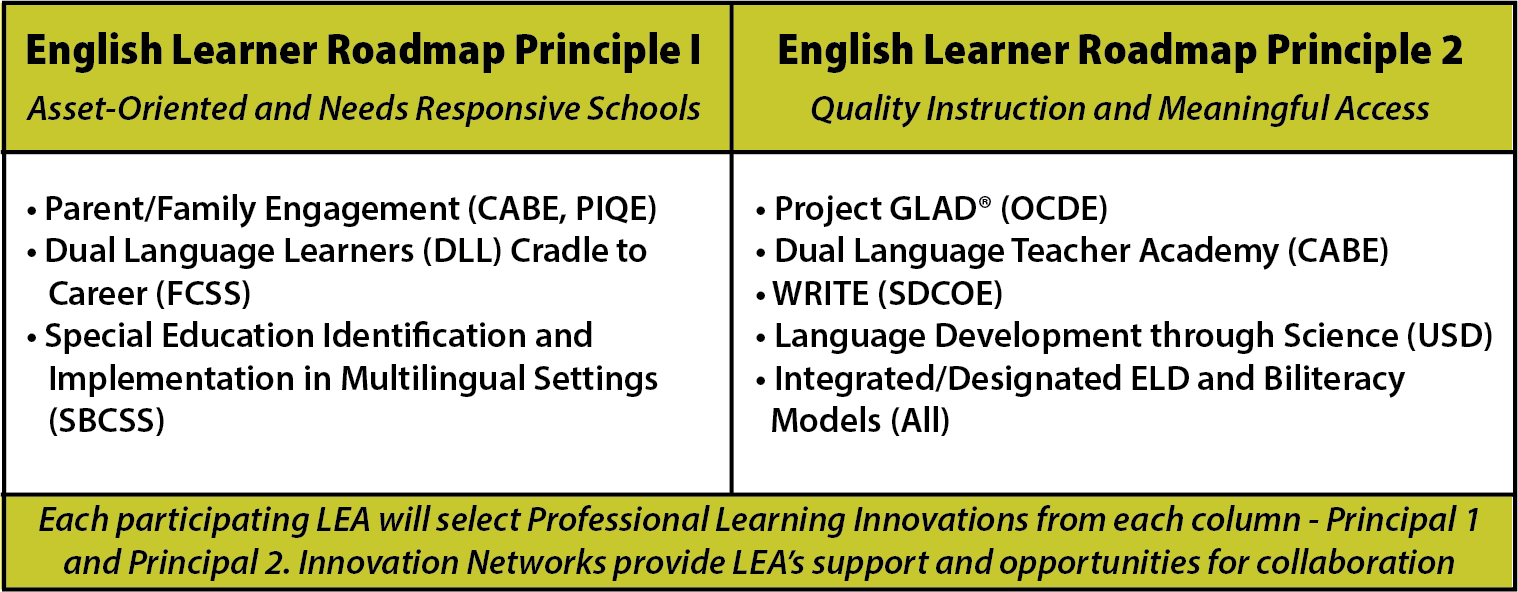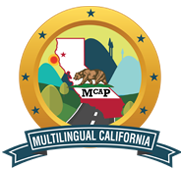WHAT IS MULTILINGUAL CALIFORNIA?

The Multilingual California Project Grant (MCaP) is a 3 year grant awarded in March, 2020 to the MCaP Alliance through the California Department of Education Educator Workforce Investment Grant Program (EWIG) to support professional learning opportunities for teachers and para-professionals across the state for implementation of the English Learner (EL) Roadmap Policy. The Multilingual California Project builds on consistently strong research documenting multilingualism as the most effective option for the academic achievement of ELs across all content areas and for preparation to participate effectively in the global workforce.
Guiding the implementation of the California English Learner Roadmap, the Multilingual California Project will deliver a powerful statewide model to strengthen the capacity of districts in dramatically accelerating the academic and multilingual opportunities, and outcomes of English Learners across California.
Guiding the implementation of the California English Learner Roadmap, the Multilingual California Project will deliver a powerful statewide model to strengthen the capacity of districts in dramatically accelerating the academic and multilingual opportunities, and outcomes of English Learners across California.
Using a four-stage model over the course of three years, Multilingual California will provide greater statewide access to and understanding of the EL Roadmap and its implementation, while also providing guidance and support to LEAs for focused, in-depth strategic development and implementation of the EL Roadmap.
GOALS

The Multilingual California Project adopts the four goals defined in the project RFA. Additionally, to ensure sustainability of the project goals adds a fifth goal outlined below:
1. Build capacity among school leaders to implement the EL Roadmap Policy including implementation of culturally and linguistically responsive practices.
2. Support implementation of instructional practices that effectively develop academic content knowledge, discipline-specific practices, academic language, integrated and designated English language development, and multilingual and multiliterate proficiency.
1. Build capacity among school leaders to implement the EL Roadmap Policy including implementation of culturally and linguistically responsive practices.
2. Support implementation of instructional practices that effectively develop academic content knowledge, discipline-specific practices, academic language, integrated and designated English language development, and multilingual and multiliterate proficiency.
3. Identify and emphasize high-quality models for professional development regarding the EL Roadmap Policy, including, but not necessarily limited to, providing coaching for principals, teacher leadership opportunities, and the implementation of other models informed by research and best practices to best meet the needs of school leaders.
4. Support the implementation, alignment, and articulation of the EL Roadmap Policy across and within school district systems.
5. Create a multilingual collaborative statewide network of experts and agencies to guide systems that support the development of effective cross-curricular, disciplinary-based instructional practices for all English Learners.
Furthermore, the network experts will support, implement, and sustain the impact of the English Learner Roadmap, aligned with CA-SS and Quality Professional Learning Standards.
4. Support the implementation, alignment, and articulation of the EL Roadmap Policy across and within school district systems.
5. Create a multilingual collaborative statewide network of experts and agencies to guide systems that support the development of effective cross-curricular, disciplinary-based instructional practices for all English Learners.
Furthermore, the network experts will support, implement, and sustain the impact of the English Learner Roadmap, aligned with CA-SS and Quality Professional Learning Standards.
PROJECT DESIGN

The Multilingual California Project plan is designed to implement the project goals and build the capacity of LEAs to implement the California English Learner Roadmap. This plan is grounded in the Quality Professional Learning Standards, and utilizes an equity-centered, continuous improvement process called Liberatory Design.
The Liberatory Design Process emerged from Stanford University’s design thinking model, with important contributions from the National Equity Project, and guides participants to explore systemic inequities across curricular areas and within the English Learner Typologies (newcomer, progressing, with disabilities, LTELs, RFEP, language background, etc).
The Liberatory Design Process emerged from Stanford University’s design thinking model, with important contributions from the National Equity Project, and guides participants to explore systemic inequities across curricular areas and within the English Learner Typologies (newcomer, progressing, with disabilities, LTELs, RFEP, language background, etc).
Educators identify the throughline of their actions to English Learner outcomes, and through continuous improvement create transformational change. Teachers, paraprofessionals, principals, and district leaders will receive on-going, job-embedded guidance, professional learning and coaching through Liberatory Design, as they build their capacity to implement the English Learner Roadmap.
As they engage in this reflective practice, LEA’s will articulate their growth goals on living documents such as: LCAP, EL/Multiliteracy Masterplan, SPSA, WASC, etc.
As they engage in this reflective practice, LEA’s will articulate their growth goals on living documents such as: LCAP, EL/Multiliteracy Masterplan, SPSA, WASC, etc.

Liberatory Design is an approach to addressing equity challenges and change efforts in complex systems. It is a process and practice to:
• Create designs that help interrupt inequity and increase opportunity for those most impacted by oppression
• Transform power by shifting the relationships between those who hold power to design and those impacted by these designs
• Generate critical learning and increased agency for those involved in the design work
• Create designs that help interrupt inequity and increase opportunity for those most impacted by oppression
• Transform power by shifting the relationships between those who hold power to design and those impacted by these designs
• Generate critical learning and increased agency for those involved in the design work
Liberatory Design is both a flexible process that can be used by teams and a set of equity leadership habits that can be practiced daily. It can be used in a variety of ways and by a variety of actors, including innovation efforts, strategic planning, community-driven design, and collaborative teams. At the core of Liberatory Design are a set of beliefs:
• Racism and inequity have been designed into systems and thus can be redesigned;
• Designing for equity requires the meaningful participation of those impacted by inequity; and
• Equity-driven designs require equity and complexity informed processes.
The Liberatory Design approach and card deck was originally created as part of a collaboration between the National Equity Project (Victor Cary and Tom Malarkey) and the Stanford d.school's K12 Lab (Tania Anaissie, David Clifford, and Susie Wise) in 2016. This crew continues to collaborate on further developing this approach.
• Racism and inequity have been designed into systems and thus can be redesigned;
• Designing for equity requires the meaningful participation of those impacted by inequity; and
• Equity-driven designs require equity and complexity informed processes.
The Liberatory Design approach and card deck was originally created as part of a collaboration between the National Equity Project (Victor Cary and Tom Malarkey) and the Stanford d.school's K12 Lab (Tania Anaissie, David Clifford, and Susie Wise) in 2016. This crew continues to collaborate on further developing this approach.
RESOURCES FOR LIBERATORY DESIGN
EVALUATION PLAN

The MCaP Evaluation is being conducted by Wexford Inc., under the direction and coordination of Sheila Cassidy and Rachel Saldivar.
For each MCaP Stage (1-4), common data are collected across all goals and specific to each goal, using:
- Stages 1 and 2 (S1&2) Formative data to monitor and understand participation, quality, usability and feasibility of services and resources for systemic development and statewide use
- S1-3 Implementation and outcome analyses to determine implementation fidelity and factors affecting implementation
- S3&4 Sustainability and impact analyses to identify changes within and across local, county, IHE and state networks/systems
For each MCaP Stage (1-4), common data are collected across all goals and specific to each goal, using:
- Stages 1 and 2 (S1&2) Formative data to monitor and understand participation, quality, usability and feasibility of services and resources for systemic development and statewide use
- S1-3 Implementation and outcome analyses to determine implementation fidelity and factors affecting implementation
- S3&4 Sustainability and impact analyses to identify changes within and across local, county, IHE and state networks/systems
Liberatory Design processes, Concerns Based Adoption Model (CBAM) tools to track adoption of innovations, NIRN Capacity Assessments (NIRN), and these tools are the basis for our data collection: ELR Self-Reflection Rubric (ELRSRR); Professional Learning System Review (PLSR); QPLS with ELR descriptors; ELR Teacher Toolkit Self-Assessments (ELRTTSA); and, the MEGA Dashboard. Quantitative and qualitative data are triangulated for rigorous analysis and findings useful within and across networks. Data collection includes participation data, milestone monitoring, surveys, interviews, focus groups, observations, and artifacts. Project staff, partners, and evaluators work together to collect, summarize, analyze and synthesize the data for continuous feedback, action steps and impact. Progress on each metric is reported annually, and cumulatively for Year 3.
The following section refers to 5 Goals (1-4 from RFA)
1. School Leader Capacity
2. Instructional Practices
3. PL Models
4. Systemic ELR Policy
5. Statewide Collaborative Network
In person and online participation is disaggregated and reported annually by goal, activity type and the following categories, with disaggregation by classrooms, schools, LEAs, counties and regions. Annual targets: 12,500 including 8,375 teachers; 625 paraeducators; 1,000 LEA and school leaders; 625 school counselors; 1,875 families.
- 90% of respondents indicate resources and PL will help them implement ELR, and identify factors inhibiting or supporting their planned action steps - 85% of Stage 2 and 3 survey respondents indicate the resources or PL helped them take action steps to implement the ELR; and factors affecting those actions - # of respondents annually indicating a mindset change toward implementation of the ELRPs (adaptation of CBAM Survey)
Goals 1-3
- Teachers completing online ELR courses, earning badges and micro-credentials targets: Y1 100, Y2 250, Y3 300
- Increase/strengthen # of bilingual authorization programs and participants in IHEs in project regions, with role groups providing feedback related to Quality Standards
- By Y3, using process and fidelity data, and artifact evidence generated through Liberatory Design to change mindset and practice
- # of teachers and administrators in 60 LEAs who have changed practices to implement the ELR (including evidence of student and family engagement, and student outcomes) based on ELRSRR, ELRTTSA, CBAM tools, and MEGA Dashboard
- At least 60% of all schools in Stage 3 LEAs implement their ELR innovation at CBAM Level 4 or higher
- Stage 3 LEAs increase implementation of each ELR Principle by at least one level on the ELRSRR, and show improvement on the PLSR of at least 2 levels for at least 5 Elements
Goal 4– By Year 3
- Expand Seal of Biliteracy support in participating LEAs PreK-16, and award credits for heritage languages, through interviews and artifacts
- Increase # of participating LEAs creating and implementing their LEA Roadmap
- Increase # and quality of biliteracy programs, based on documentation, artifacts observations
Goal 5– By Year 3
- Increase levels of collaboration (based on artifacts and the Tamarack Institute Collaboration Spectrum) with partner network, advisory council, IHE networks, other CA networks, CA-SS (e.g., EL Directors)
- Each PIT increases at least one level on the NIRN tool to assess their capacities to facilitate their work
- Inventory of grant-produced resources from Language Centers and partner agencies
- # LEAs committed to Multilingual CA as evidenced by Pledge artifacts
- 2 members of District Roadmap Team (20 total) are trainers for their LEAs/regions
The following section refers to 5 Goals (1-4 from RFA)
1. School Leader Capacity
2. Instructional Practices
3. PL Models
4. Systemic ELR Policy
5. Statewide Collaborative Network
In person and online participation is disaggregated and reported annually by goal, activity type and the following categories, with disaggregation by classrooms, schools, LEAs, counties and regions. Annual targets: 12,500 including 8,375 teachers; 625 paraeducators; 1,000 LEA and school leaders; 625 school counselors; 1,875 families.
- 90% of respondents indicate resources and PL will help them implement ELR, and identify factors inhibiting or supporting their planned action steps - 85% of Stage 2 and 3 survey respondents indicate the resources or PL helped them take action steps to implement the ELR; and factors affecting those actions - # of respondents annually indicating a mindset change toward implementation of the ELRPs (adaptation of CBAM Survey)
Goals 1-3
- Teachers completing online ELR courses, earning badges and micro-credentials targets: Y1 100, Y2 250, Y3 300
- Increase/strengthen # of bilingual authorization programs and participants in IHEs in project regions, with role groups providing feedback related to Quality Standards
- By Y3, using process and fidelity data, and artifact evidence generated through Liberatory Design to change mindset and practice
- # of teachers and administrators in 60 LEAs who have changed practices to implement the ELR (including evidence of student and family engagement, and student outcomes) based on ELRSRR, ELRTTSA, CBAM tools, and MEGA Dashboard
- At least 60% of all schools in Stage 3 LEAs implement their ELR innovation at CBAM Level 4 or higher
- Stage 3 LEAs increase implementation of each ELR Principle by at least one level on the ELRSRR, and show improvement on the PLSR of at least 2 levels for at least 5 Elements
Goal 4– By Year 3
- Expand Seal of Biliteracy support in participating LEAs PreK-16, and award credits for heritage languages, through interviews and artifacts
- Increase # of participating LEAs creating and implementing their LEA Roadmap
- Increase # and quality of biliteracy programs, based on documentation, artifacts observations
Goal 5– By Year 3
- Increase levels of collaboration (based on artifacts and the Tamarack Institute Collaboration Spectrum) with partner network, advisory council, IHE networks, other CA networks, CA-SS (e.g., EL Directors)
- Each PIT increases at least one level on the NIRN tool to assess their capacities to facilitate their work
- Inventory of grant-produced resources from Language Centers and partner agencies
- # LEAs committed to Multilingual CA as evidenced by Pledge artifacts
- 2 members of District Roadmap Team (20 total) are trainers for their LEAs/regions
INNOVATIONS
Based on the initial identification of equity gaps through the Liberatory Design framework, the LEAs will address those gaps in EL opportunities and achievement across the PK-16 pipeline by implementing key Professional Learning Innovations supporting the implementation of Principle 1 and Principle 2 of the EL Roadmap (See table below). These researched-based Professional Learning Innovations, listed in the table below, are offered by CABE and the five county offices showcasing the capacity and strengths they bring to this project.

